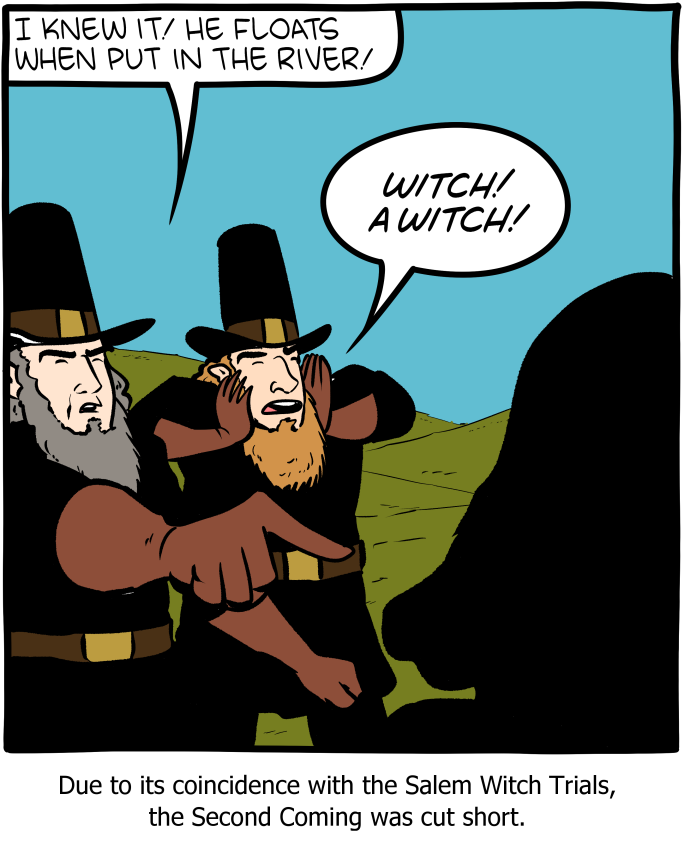
Click here to go see the bonus panel!
Hovertext:
This is why he doesn't come back for humans any more.
Today's News:

Hovertext:
This is why he doesn't come back for humans any more.
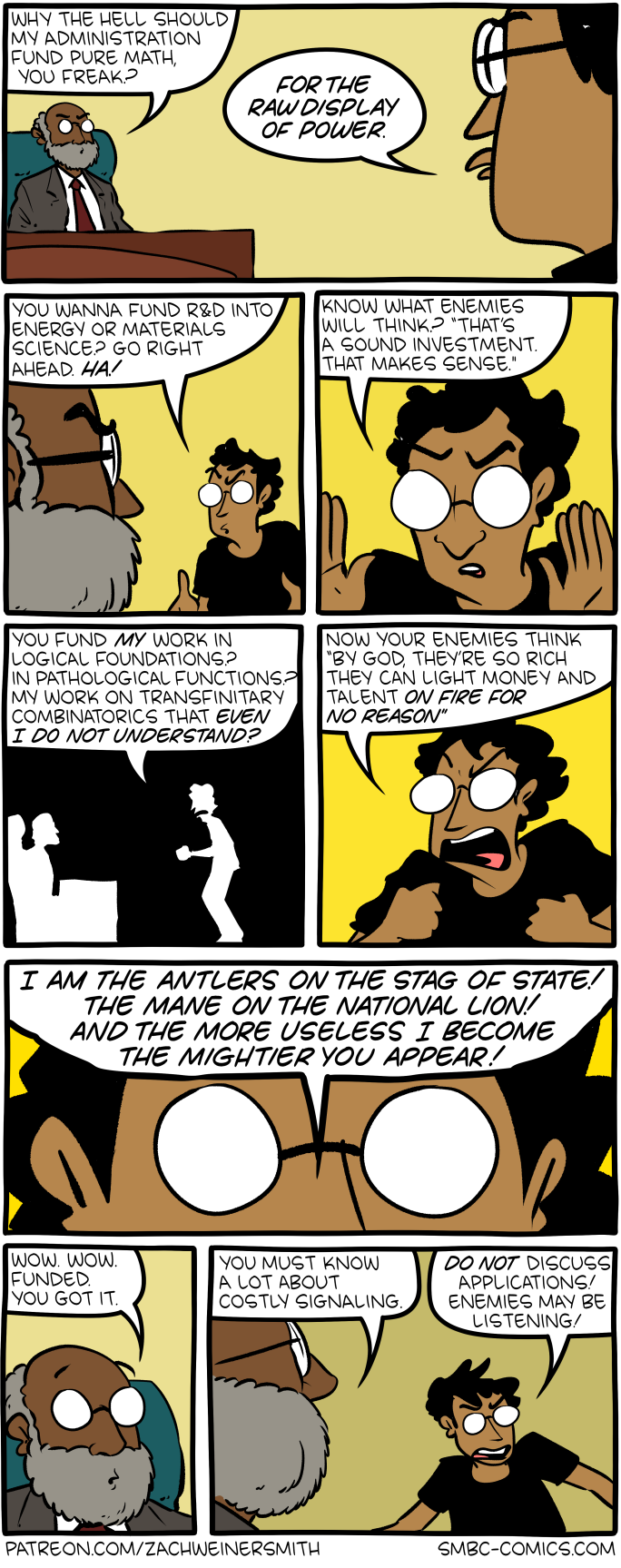
Hovertext:
Tragically, once you introduce costly signaling, all mathematics is impure.
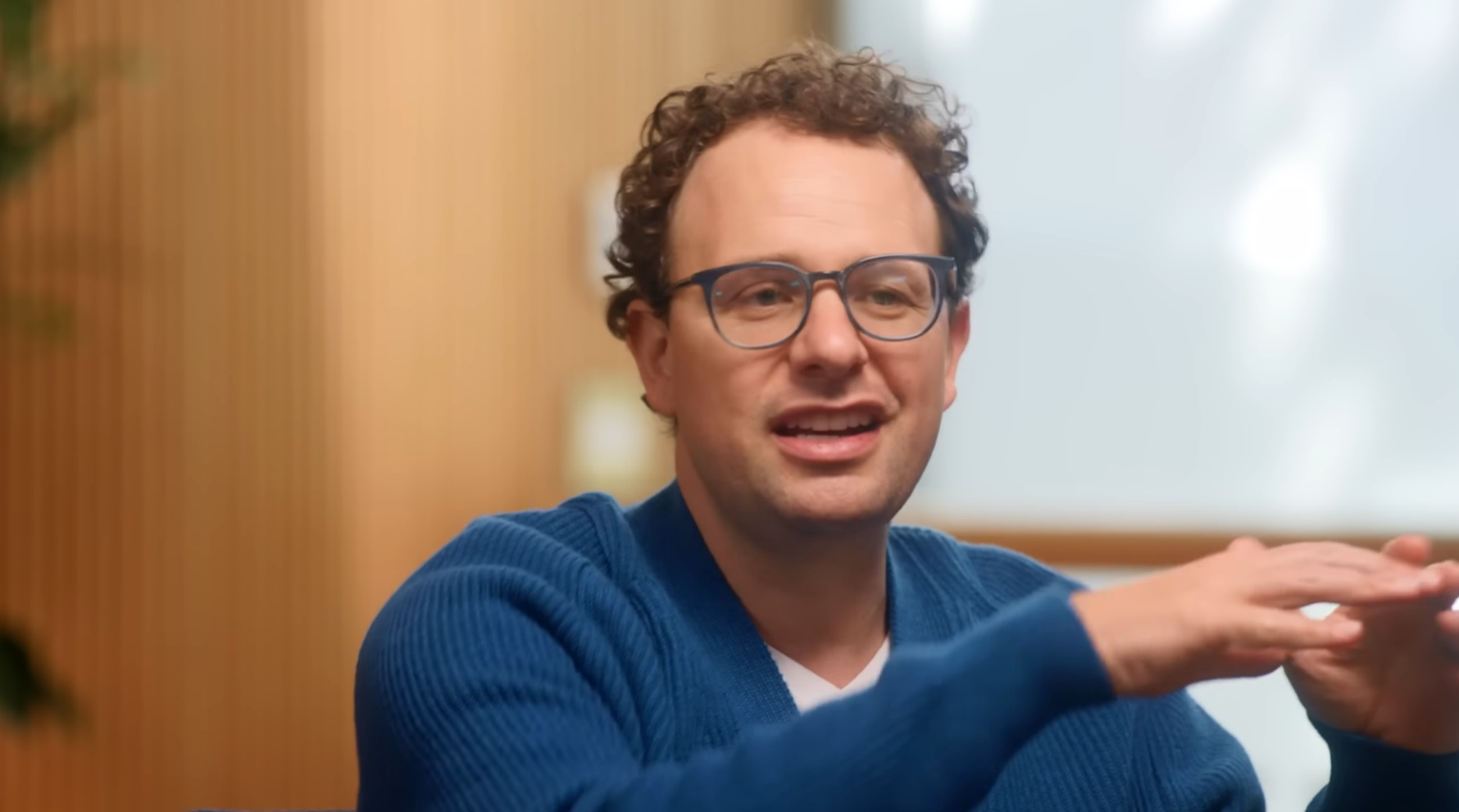
Anthropic CEO Dario Amodei has published a lengthy statement on the company’s site in which he promises Anthropic’s AI models are not politically biased, that it remains committed to American leadership in the AI industry, and that it supports the AI startup space in particular.
Amodei doesn’t explicitly say why he feels the need to state all of these obvious positions for the CEO of an American AI company to have, but the reason is that the Trump administration’s so-called “AI Czar” has publicly accused Anthropic of producing “woke AI” that it’s trying to force on the population via regulatory capture.
The current round of beef began earlier this month when Anthropic’s co-founder and head of policy Jack Clark published a written version of a talk he gave at The Curve AI conference in Berkeley. The piece, published on Clark’s personal blog, is full of tortured analogies and self-serving sci-fi speculation about the future of AI, but essentially boils down to Clark saying he thinks artificial general intelligence is possible, extremely powerful, potentially dangerous, and scary to the general population. In order to prevent disaster, put the appropriate policies in place, and make people embrace AI positively, he said, AI companies should be transparent about what they are building and listen to people’s concerns.
“What we are dealing with is a real and mysterious creature, not a simple and predictable machine,” he wrote. “And like all the best fairytales, the creature is of our own creation. Only by acknowledging it as being real and by mastering our own fears do we even have a chance to understand it, make peace with it, and figure out a way to tame it and live together.”
Venture capitalist, podcaster, and the White House’s “AI and Crypto Czar” David Sacks was not a fan of Clark’s blog.
“Anthropic is running a sophisticated regulatory capture strategy based on fear-mongering,” Sacks said on X in response to Clark’s blog. “It is principally responsible for the state regulatory frenzy that is damaging the startup ecosystem.”
Things escalated yesterday when Reid Hoffman, LinkedIn’s co-founder and a megadonor to the Democratic party, supported Anthropic in a thread on X, saying “Anthropic was one of the good guys” because it's one of the companies “trying to deploy AI the right way, thoughtfully, safely, and enormously beneficial for society.” Hoffman also appeared to take a jab at Elon Musk’s xAI, saying “Some other labs are making decisions that clearly disregard safety and societal impact (e.g. bots that sometimes go full-fascist) and that’s a choice. So is choosing not to support them.”
Sacks responded to Hoffman on X, saying “The leading funder of lawfare and dirty tricks against President Trump wants you to know that ‘Anthropic is one of the good guys.’ Thanks for clarifying that. All we needed to know.” Musk hopped into the replies saying: “Indeed.”
“The real issue is not research but rather Anthropic’s agenda to backdoor Woke AI and other AI regulations through Blue states like California,” Sacks said. Here, Sacks is referring to Anthropic’s opposition to Trump’s One Big Beautiful Bill, which wanted to stop states from regulating AI in any way for 10 years, and its backing of California’s SB 53, which requires AI companies that generate more than $500 million in annual revenue to make their safety protocols public.
All this sniping leads us to Amodei’s statement today, which doesn’t mention the beef above but is clearly designed to calm investors who are watching Trump’s AI guy publicly saying one of the biggest AI companies in the world sucks.
“I fully believe that Anthropic, the administration, and leaders across the political spectrum want the same thing: to ensure that powerful AI technology benefits the American people and that America advances and secures its lead in AI development,” Amodei said. “Despite our track record of communicating frequently and transparently about our positions, there has been a recent uptick in inaccurate claims about Anthropic's policy stances. Some are significant enough that they warrant setting the record straight.”
Amodei then goes to count the ways in which Anthropic already works with the federal government and directly grovels to Trump.
“Anthropic publicly praised President Trump’s AI Action Plan. We have been supportive of the President’s efforts to expand energy provision in the US in order to win the AI race, and I personally attended an AI and energy summit in Pennsylvania with President Trump, where he and I had a good conversation about US leadership in AI,” he said. “Anthropic’s Chief Product Officer attended a White House event where we joined a pledge to accelerate healthcare applications of AI, and our Head of External Affairs attended the White House’s AI Education Taskforce event to support their efforts to advance AI fluency for teachers.”
The more substantive part of his argument is that Anthropic didn’t support SB 53 until it made an exemption for all but the biggest AI labs, and that several studies found that Anthropic’s AI models are not “uniquely politically biased,” (read: not woke).
“Again, we believe we share those goals with the Trump administration, both sides of Congress, and the public,” Amodei wrote. “We are going to keep being honest and straightforward, and will stand up for the policies we believe are right. The stakes of this technology are too great for us to do otherwise.”
Many of the AI industry’s most vocal critics would agree with Sacks that Clark’s blog and “fear-mongering” about AI is self-serving because it makes their companies seem more valuable and powerful. Some critics will also agree that AI companies take advantage of that perspective to then influence AI regulation in a way that benefits them as incumbents.
It would be a far more compelling argument if it didn’t come from Sacks and Musk, who found a much better way to influence AI regulation to benefit their companies and investments: working for the president directly and publicly bullying their competitors.
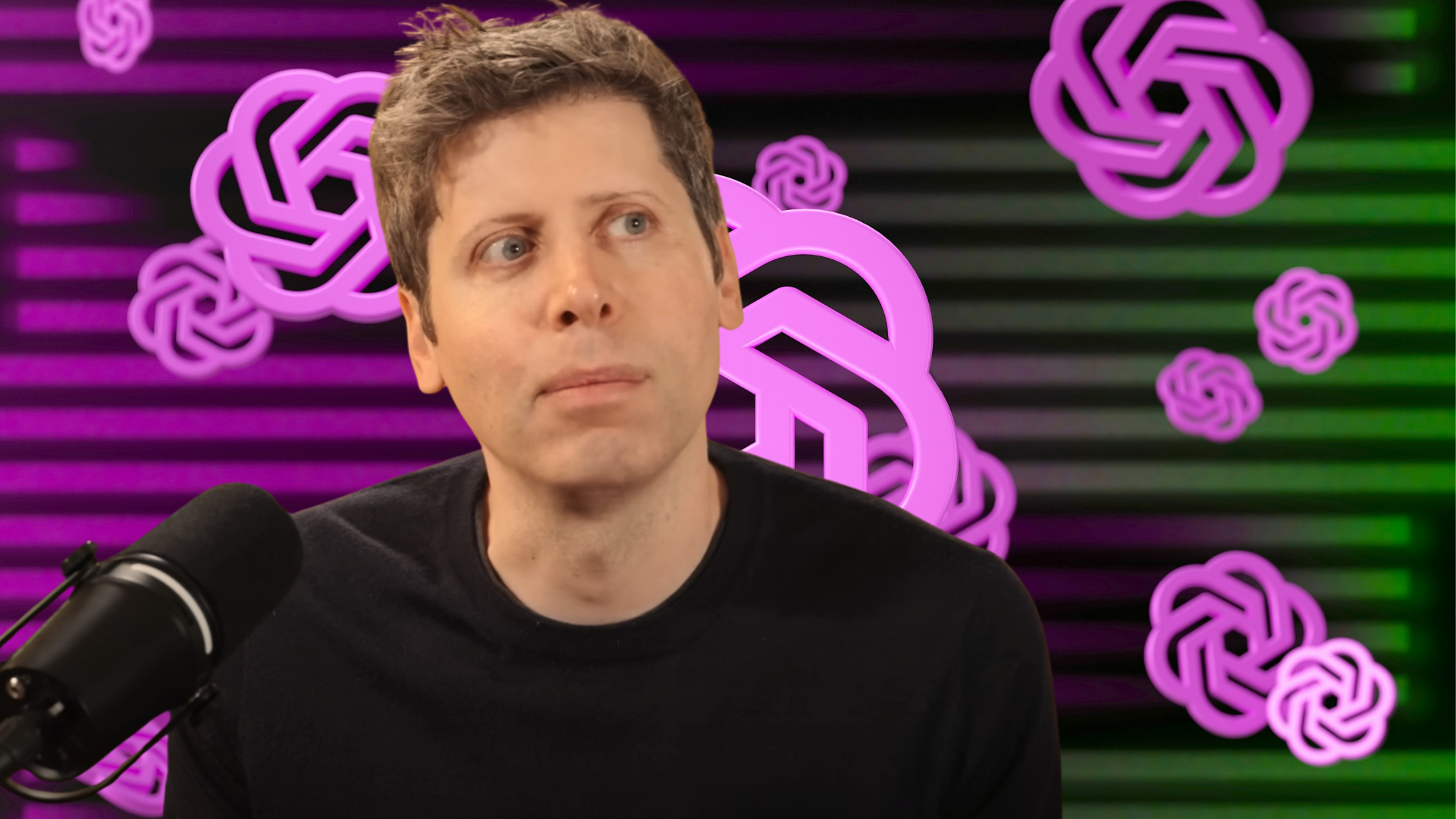
OpenAI CEO Sam Altman appeared on Cleo Abram's podcast in August where he said the company was “tempted” to add sexual content in the past, but resisted, saying that a “sex bot avatar” in ChatGPT would be a move to “juice growth.” In light of his announcement last week that ChatGPT would soon offer erotica, revisiting that conversation is revealing.
It’s not clear yet what the specific offerings will be, or whether it’ll be an avatar like Grok’s horny waifu. But OpenAI is following a trend we’ve known about for years: There are endless theorized applications of AI, but in the real world many people want to use LLMs for sexual gratification, and it’s up for the market to keep up. In 2023, a16z published an analysis of the generative AI market, which amounted to one glaringly obvious finding: people use AI as part of their sex lives. As Emanuel wrote at the time in his analysis of the analysis: “Even if we put ethical questions aside, it is absurd that a tech industry kingmaker like a16z can look at this data, write a blog titled ‘How Are Consumers Using Generative AI?’ and not come to the obvious conclusion that people are using it to jerk off. If you are actually interested in the generative AI boom and you are not identifying porn as a core use for the technology, you are either not paying attention or intentionally pretending it’s not happening.”
Altman even hinting at introducing erotic roleplay as a feature is huge, because it’s a signal that he’s no longer pretending. People have been fucking the chatbot for a long time in an unofficial capacity, and have recently started hitting guardrails that stop them from doing so. People use Anthropic’s Claude, Google’s Gemini, Elon Musk’s Grok, and self-rolled large language models to roleplay erotic scenarios whether the terms of use for those platforms permit it or not, DIYing AI boyfriends out of platforms that otherwise forbid it. And there are specialized erotic chatbot platforms and AI dating simulators, but what OpenAI does—as the owner of the biggest share of the chatbot market—the rest follow.

Already we see other AI companies stroking their chins about it. Following Altman’s announcement, Amanda Askell, who works on the philosophical issues that arise with Anthropic’s alignment, posted: “It's unfortunate that people often conflate AI erotica and AI romantic relationships, given that one of them is clearly more concerning than the other. Of the two, I'm more worried about romantic relationships. Mostly because it seems like it would make users pretty vulnerable to the AI company in many ways. It seems like a hard area to navigate responsibly.” And the highly influential anti-porn crowd is paying attention, too: the National Center on Sexual Exploitation put out a statement following Altman’s post declaring that actually, no one should be allowed to do erotic roleplay with chatbots, not even adults. (Ron DeHaas, co-founder of Christian porn surveillance company Covenant Eyes, resigned from the NCOSE board earlier this month after his 38-year-old adult stepson was charged with felony child sexual abuse.)
In the August interview, Abram sets up a question for Altman by noting that there’s a difference between “winning the race” and “building the AI future that would be best for the most people,” noting that it must be easier to focus on winning. She asks Altman for an example of a decision he’s had to make that would be best for the world but not best for winning.
Altman responded that he’s proud of the impression users have that ChatGPT is “trying to help you,” and says a bunch of other stuff that’s not really answering the question, about alignment with users and so on. But then he started to say something actually interesting: “There's a lot of things we could do that would like, grow faster, that would get more time in ChatGPT, that we don't do because we know that like, our long-term incentive is to stay as aligned with our users as possible. But there's a lot of short-term stuff we could do that would really juice growth or revenue or whatever, and be very misaligned with that long-term goal,” Altman said. “And I'm proud of the company and how little we get distracted by that. But sometimes we do get tempted.”
“Are there specific examples that come to mind?” Abram asked. “Any decisions that you've made?”
After a full five-second pause to think, Altman said, “Well, we haven't put a sex bot avatar in ChatGPT yet.”
“That does seem like it would get time spent,” Abram replied. “Apparently, it does.” Altman said. They have a giggle about it and move on.
Two months later, Altman was surprised that the erotica announcement blew up. “Without being paternalistic we will attempt to help users achieve their long-term goals,” he wrote. “But we are not the elected moral police of the world. In the same way that society differentiates other appropriate boundaries (R-rated movies, for example) we want to do a similar thing here.”
This announcement, aside from being a blatant hail mary cash grab for a company that’s bleeding funds because it’s already too popular, has inspired even more “bubble’s popping” speculation, something boosters and doomers alike have been saying (or rooting for) for months now. Once lauded as a productivity godsend, AI has mostly proven to be a hindrance to workers. It’s interesting that OpenAI’s embrace of erotica would cause that reaction, and not, say, the fact that AI is flooding and burdening libraries, eating Wikipedia, and incinerating the planet. It’s also interesting that OpenAI, which takes user conversations as training data—along with all of the writing and information available on the internet—feels it’s finally gobbled enough training data from humans to be able to stoop so low, as Altman’s attitude insinuates, to let users be horny. That training data includes authors of romance novels and NSFW fanfic but also sex workers who’ve spent the last 10 years posting endlessly to social media platforms like Twitter (pre-X, when Elon Musk cut off OpenAI’s access) and Reddit, only to have their posts scraped into the training maw.
Altman believes “sex bots” are not in service of the theoretical future that would “benefit the most people,” and that it’s a fast-track to juicing revenue, something the company badly needs. People have always used technology for horny ends, and OpenAI might be among the last to realize that—or the first of the AI giants to actually admit it.
In a quiet Cupertino, California neighborhood just a few miles from Apple’s campus and near the city’s iconic Eichler district, SHED Architecture & Design has designed a home that feels both timeless and distinctly modern. The Cupertino Courtyard House sits on a modest flat lot surrounded by homes in Mission and Spanish Colonial styles, yet it stands apart – grounded in local architectural lineage while reimagining it for a new generation.
From the street, the residence leans into modern while following the strict design requirements of the area. White stucco landscape walls give nod to the Mediterranean vernacular of its surroundings, while a dark, charred-wood upper volume – clad in shou sugi ban – announces a bolder contemporary sensibility. The home’s entry is behind a slatted wood gate, partially hidden between concrete walls, through a small, secluded courtyard. This path leads to a recessed “genkan,” a traditional Japanese threshold where shoes are removed.
Inside, the home unfolds as a collection of interior courtyards, each one framing views of the outdoors. Floor-to-ceiling glass doors blur the lines between interior and garden, letting natural light highlight the plaster walls and oak finishes throughout the day. The living, dining, and kitchen areas flow together along the rear of the property, anchored by custom white oak built-ins that double as storage and seating. A bench built into the back of the kitchen island transforms the space into an informal gathering hub.
The materials palette exudes cozy warmth and natural tactility. Clay plaster, wood, and slate bring an earthy softness that contrasts the home’s geometric, black and white exterior. A covered “engawa” – a Japanese-style porch hovering just above the ground – extends the living spaces outdoors, inviting quiet moments of reflection.
At the center of the layout, a skylit stairwell serves as a sculptural element that leads to the second floor. Designed for passive ventilation, it channels light and air through the home while discreetly housing mechanical systems. Upstairs, the compact footprint is organized with efficiency: the primary suite features a slate-lined wet room and a cedar soaking tub, while the children’s rooms each include playful lofts for rest and imagination.
Performance was as much a priority as aesthetics. The house exceeds net-zero energy standards with a rooftop solar array generating more power than it consumes. High-efficiency systems – from heat pump HVAC and water heating to energy recovery ventilation – combine with advanced framing and airtight insulation to minimize waste. Every fixture, material, and assembly was considered for longevity and environmental impact, ensuring the home not only looks but lives sustainably.
To learn more about the Cupertino Courtyard House by SHED Architecture & Design, please visit shedbuilt.com.
Photography by Ethan Gordon.
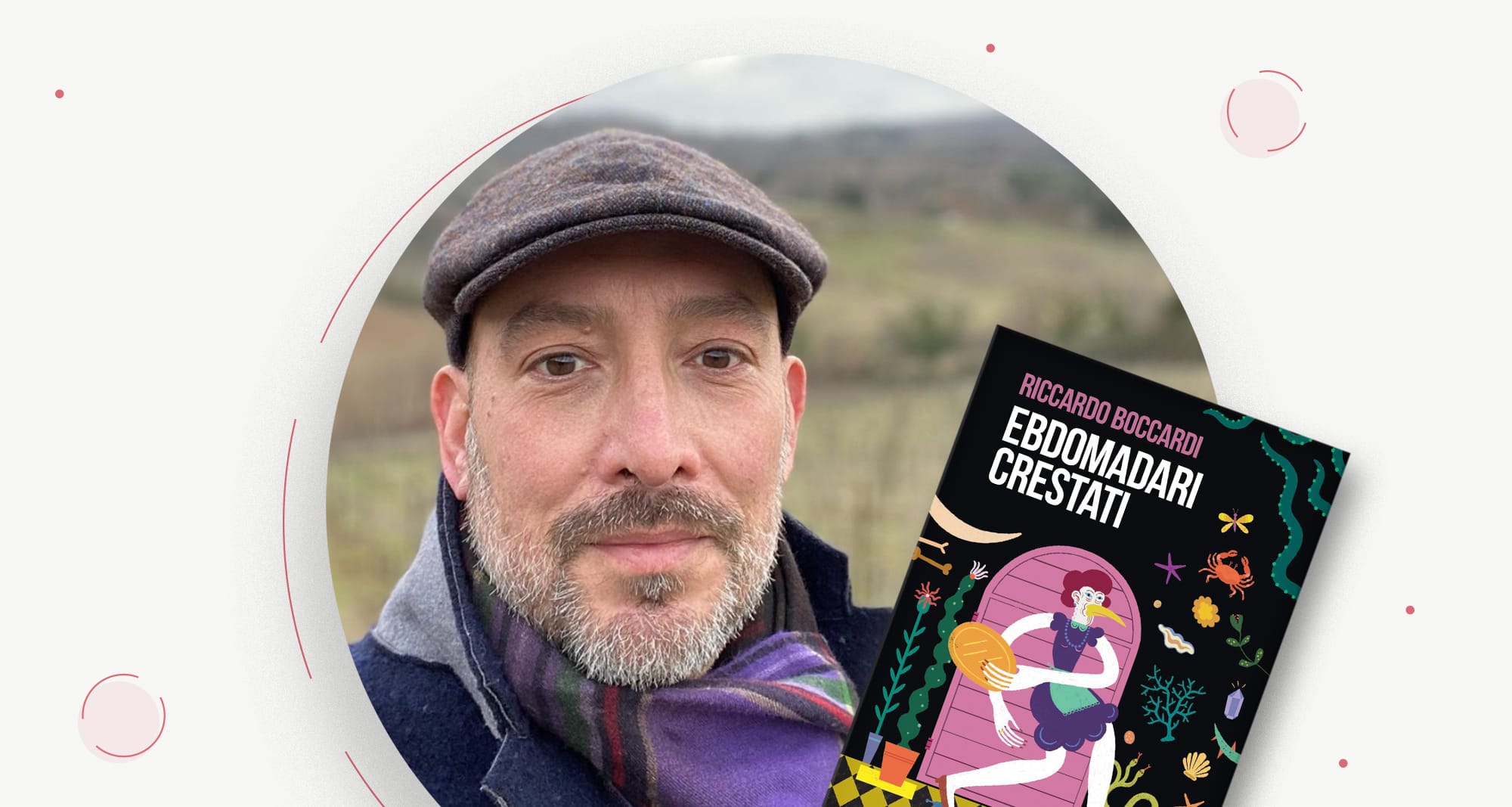
Riccardo Boccardi is a writer from Montalcino, Italy, known for creating Racconti Crestati, a vast collection of micro-stories each just under 600 characters long. Aside from being an impressive achievement in its own right, Riccardo’s stories have also inspired more than a thousand illustrations and several musical jingles by other artists. A selection of stories has turned into two published books as well as university teaching materials.
Can you tell us a bit more about Racconti Crestati and what inspired you to create this interesting project?
It all started in 2017 with the creation of a simple Facebook page. The idea was to share short stories, as long as a single post, meant to be read perhaps on the subway or while waiting for a bus. They had to suit a new form of communication: fast, immediate, and capable of capturing attention in just a few seconds. I named the project “Racconti Crestati” (Crested Stories) and chose a Mohawk hairstyle as its logo. The hairstyle symbolized the principle behind these stories: they needed to be direct, sharp, and full of character. Just like that haircut, all the superfluous was stripped away, leaving only what was essential. At first, I wrote a story every day, but the pace soon became unsustainable, so I switched to one “crested” story per week. Since then, these texts have been my companions: through them, I capture thoughts, visions, and fantasies, giving life to tales that are often grotesque or surreal.
As a writer, what draws you to the short story, or more like, micro-story form?
At its core, it’s about explosiveness. Everything unfolds in just a few breaths, even though each story can continue to echo in the reader’s mind long afterward. In my writing, I always try to suggest a “before” and an “after” surrounding the events I narrate: this way, time stretches, and the characters take on a fuller life in the reader’s imagination. Thanks to their brevity, micro-stories allow me to explore a wide variety of themes and literary genres, from the grotesque to noir, from romance to science fiction. Sometimes a single line of dialogue is enough to spark an entire story. Other times, the tales emerge from playful linguistic experiments, such as tautograms or lipograms.
It seems clear from your project that you enjoy working with constraints—what motivated you to set the limit of just under 600 characters for each story? How do these limitations foster creativity in your writing?
At first, when I was drafting my texts, I hadn’t set a precise length—let alone the strict one I follow today. Over the weeks, however, two guiding numbers emerged: 597 and 598. In fact, each of my stories must meet one of these character counts (excluding spaces, title included). Within this exact framework, my imagination moves freely, and my creativity is honed. In such a small space, every sentence, every word, every punctuation mark must be carefully chosen to create the right rhythm and evoke the intended atmosphere. What might seem like a limitation is, in fact, my greatest freedom: it allows me to cross boundaries I otherwise could not.
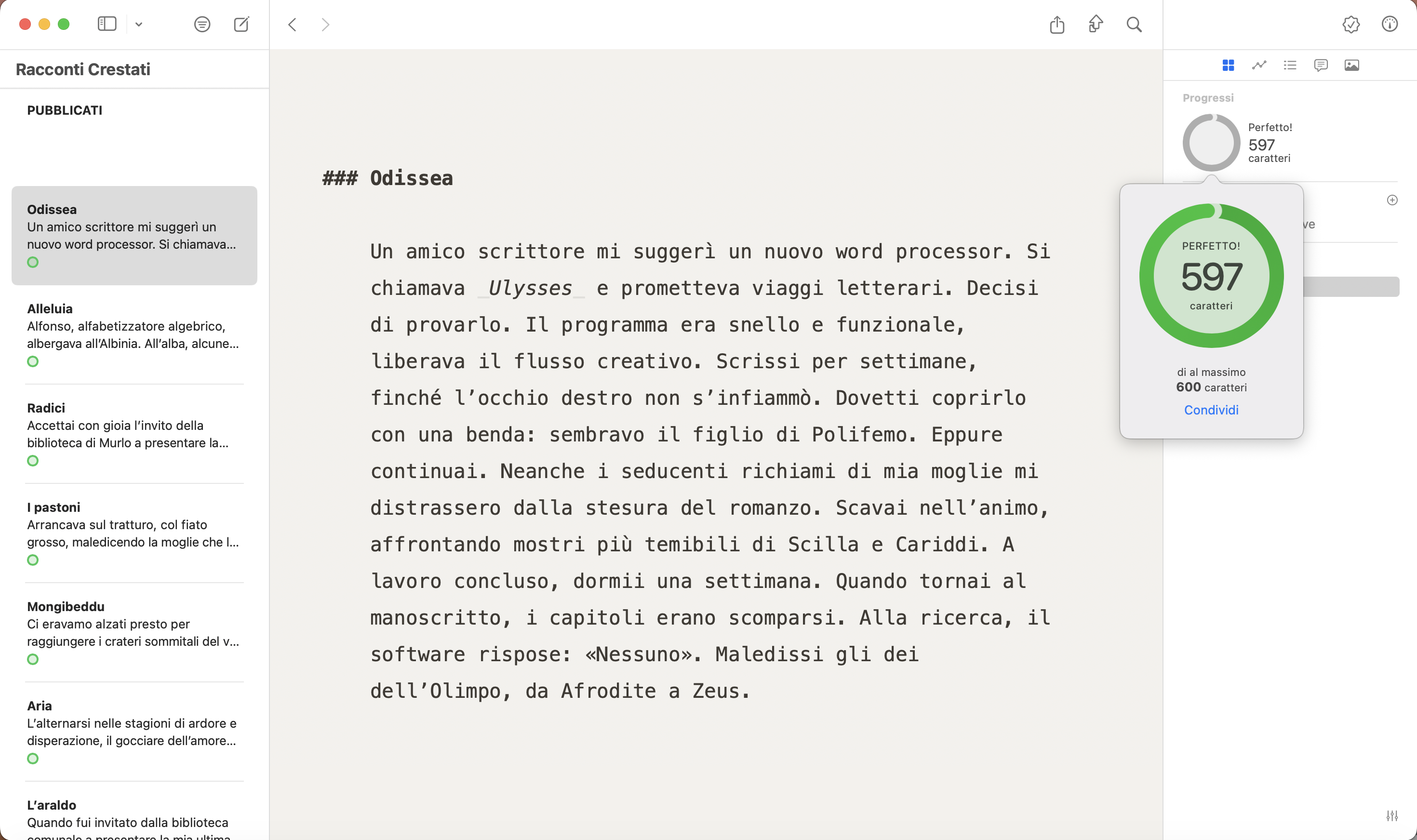
What is your creative process for crafting each of these concise stories? How does your writing routine look, and how has it contributed to your creative output?
Stories can emerge from a variety of sources: an everyday event pushed to the extreme, a person you meet who becomes a character, the musicality of a single word that becomes the story’s pivot, or a dormant memory that resurfaces and transforms. I don’t follow a strict routine: I set my goal in Ulysses (a maximum of 600 characters, excluding spaces) and then develop the story. Usually, I already know the ending and write the story backward. Other times, I begin with a theme or a striking image. Some “crested” stories are born quickly, while others require weeks of gestation before they come to life.
You have been using Ulysses since its very first release, which was in 2003, and have written over 570 micro-stories with it. What makes Ulysses such a perfect writing companion for you?
The first time I used Ulysses, I didn’t fully grasp its structure or potential. It was revolutionary: minimal, essential, almost stark in its simplicity. Everything existed in a shared, undefined space—no separate files, no folders, no formatting tools. Only through regular use did I come to appreciate the hidden power beneath its simplicity, and the advantages it offered both in the creative process and in managing texts structurally. Since then, it has become my daily writing companion. The ability to organize hundreds of texts with clarity and security is unmatched. The only thing I miss is the icon from the earliest versions: that “U”, part bard’s lyre, part Minotaur’s horns.
Writing over 570 micro-stories surely changes how you perceive narrative over time. How has this influenced your understanding of storytelling or your approach to new creative ideas?
Essentially, it has allowed me to sharpen my imagination, explore a wide variety of themes, and blend the comic with the dramatic, and vice versa. The natural science knowledge I gained at university has found new life in this literary form, which preserves the rigor and organizational skills of science. Metamorphoses, symbioses, geological events, and peculiar creatures often take center stage in my stories. Condensing, optimizing, and synthesizing are integral to the way I think, which is why the ultra-short form of writing suits me so well. Yet it remains a valuable exercise: when practiced consistently, it helps uncover new narrative and linguistic solutions, making each text more impactful in its brevity.
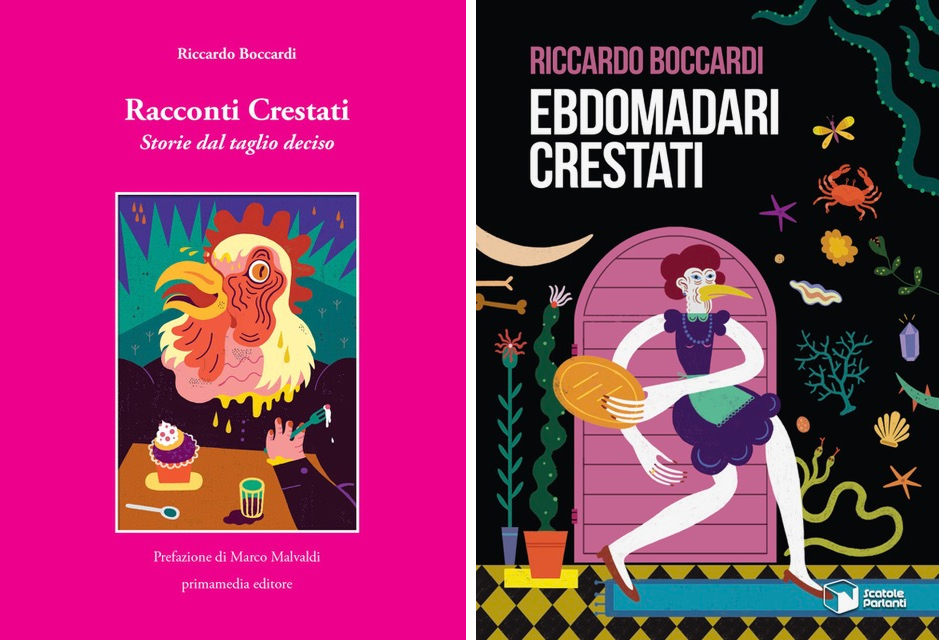
Even though all micro romanzi (micro-stories) are written by you, there is a strong encouragement of collaboration in this project. What is it like working together with illustrators, performers, and musicians? Do you feel that such interpretations elevate your stories, and, in turn, is your writing also influenced by other art forms, such as music, film, or visual arts?
Yes, the project has had a collaborative and voluntary spirit from the very beginning. It started with readings by Italian crime writers, then moved to illustrations—now numbering around 1,300—followed by performances from actors and voice-over artists, and finally musical jingles. Many of these collaborations are international, stretching from China to Chile, from Spain to Russia. The magic of it all lies in the fact that each creation springs from just a handful of words—a few sentences capable of connecting continents. Without a doubt, art feeds art, and I am constantly amazed at how illustrators interpret the stories in ways I had never imagined. As for influences on my writing, I believe every experience adds a new layer to the creative process: cinema, music, TV series, books, comics, or even simply lounging on the sofa.
It is clear that Racconti Crestati spread widely in the art world, crossing into many fields beyond writing. Was that your plan from the start, or did it grow in that direction over time? And what impact do you wish to create with this project?
The original idea was simply to bring new “interesting” content to a social network that, even then, was filled with images and trivialities. Collaborations began shortly after, sparked by simple requests sent through Facebook. As you can see, generosity is far from dead…
As for the future of Crested Stories, I don’t have any specific plans at the moment, apart from continuing to write and nurturing artistic collaborations.
This is a digital-first project, with all stories freely available on the project’s website (www.racconticrestati.com), but it has also grown to include printed editions with two published books. Can you tell us how Racconti Crestati evolved from digital shorts to printed books? And how has reader feedback, especially from online platforms, influenced the direction of the project?
Two collections of micro-stories have been published: one in 2019 (“Racconti Crestati”, Primamedia Editore) and one this year (“Ebdomadari Crestati”, Scatole Parlanti). The first contains 196 stories, the second 200. Both include a previously unpublished story that never appeared online. Transitioning from the web to print required careful selection and refinement of the texts: when something is printed, it demands the utmost attention and precision. “Scripta manent”, as my Latin ancestors used to say. Although short stories are not widely appreciated by the general public in Italy, both publishers embraced these brief tales enthusiastically—perhaps because of their unusual conciseness and themes. Reader feedback hasn’t shaped the project, but today, fans of the “crested” stories can enjoy them online and also have a physical copy on their bedside table.
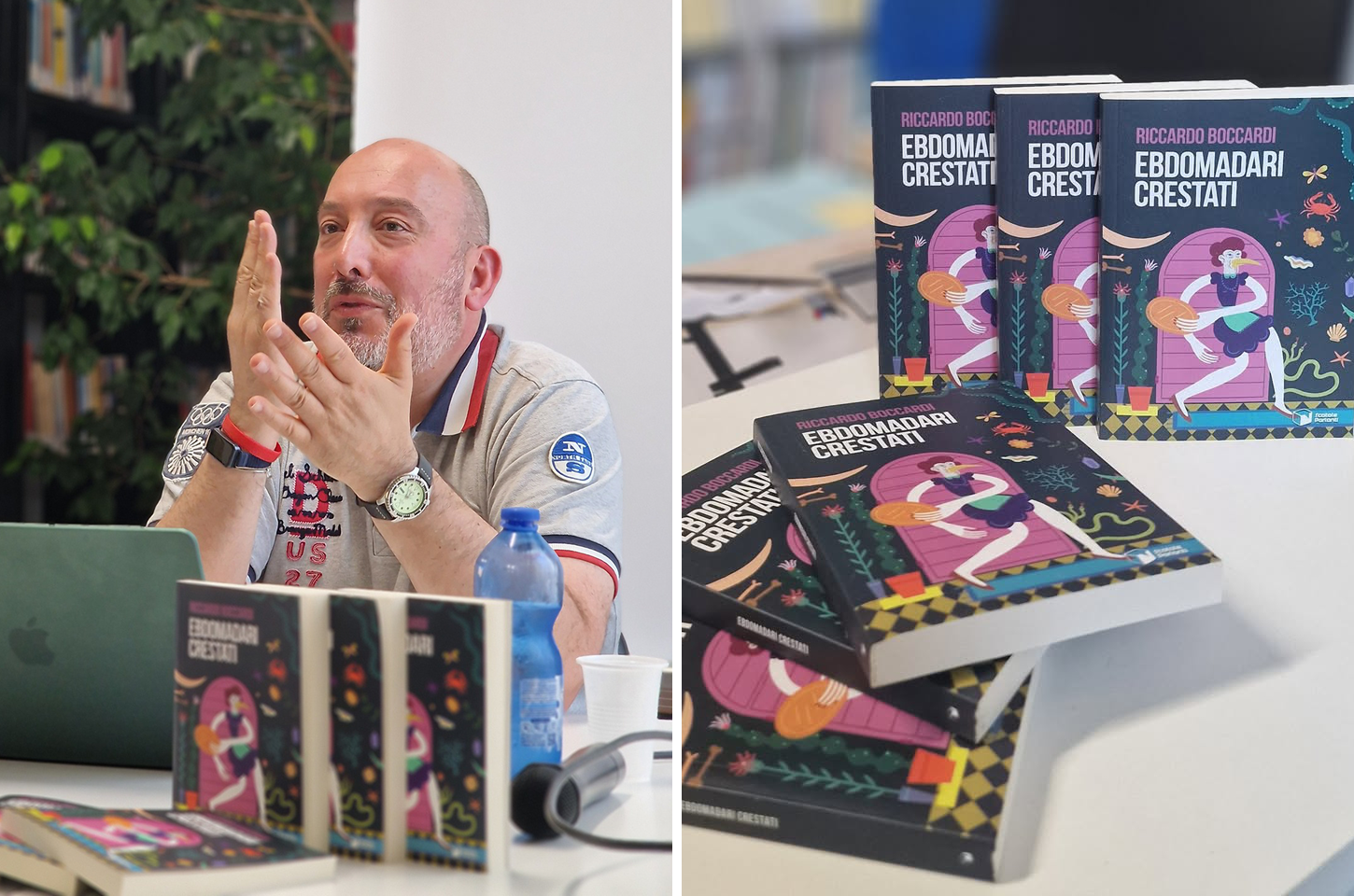
One of the books was also used as teaching material in a storytelling course at the University of Turin. How did this come about? Could you share your thoughts on what micro-stories can teach us about storytelling? What insights have you gathered during this project that you’d like to share with aspiring short story writers?
From the very beginning, my stories received the appreciation of Alessandro Perissinotto, an Italian crime writer and storytelling professor at the University of Turin. When my first printed collection was released, Alessandro—who later wrote the preface for the second anthology—selected Crested Stories as recommended reading for his course. It was a tremendous honor, and I still take this opportunity to thank him.
I believe micro-stories offer the chance to experiment with a variety of narrative techniques: ellipses, plot twists, reversals, temporal contractions or expansions (as perceived by the reader), and the evocative power of words. My advice for anyone venturing into short-form writing is simple: write. Often, people are drawn only to the idea of being a writer, without realizing how demanding, solitary, and sometimes frustrating it can be to turn one’s imagination into words. The message is clear: write even when you don’t feel like it. With a bit of luck, inspiration will follow.
Lastly, after many years of writing micro-stories, how do you see the future of Racconti Crestati? Are there new formats, collaborations, or directions you’d like to explore next?
I believe this project will continue to accompany me for several more years: by now, these short stories have become an integral part of the way I view the world, its people, and its events. Often, when observing a face, a gesture, or a situation, I can already see one of my quirky stories taking shape. Looking ahead, I remain open to all kinds of artistic collaborations, without restrictions of genre or form. I have also experimented with longer stories, earning positive reviews and recognition in national competitions. My current goal is still the publication of a novel… but if that doesn’t come to pass, I can always weave together a thousand micro-stories.
If you’d like to read more from Riccardo, make sure to check out his personal website or his project's website and Facebook page.